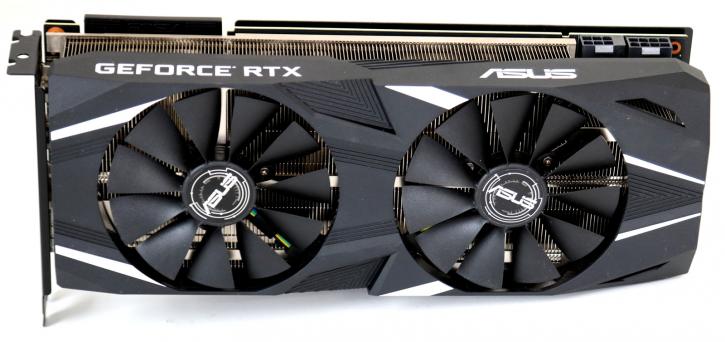Conclusion
Conclusion
The DUAL OC version of the RTX 2080 from ASUS is a more plain product, however, it offers reference performance and can be tweaked just as well. You save roughly 60 bucks over say the STRIX model, but forfeit on a more aesthetically pleasing design. In terms of cooling and performance, it's all in that same nominal baseline of performance though. One thing I'd like to note is that this card did exhibit coil whine, in a closed environment (chassis) it'll be harder to hear though. A STRIX OC model will start at € 829,- and this DUAL version at € 769,- in the EU with varying numbers per region. USD prices should be a roughly the same. Wether or not the price premium is worth the RT and Tensor cores, only you can decide of course.
Aesthetics
As stated, the DUAL version is more plain looking. It's rather thick, has no RGB LEDs, is a dual-fan cooler based product and the rear backplate imho is a little 'shouty'. Other then that though, we cannot complain. it's using a fairly usable black/white design that fits many PCs. And for those that have a closed chassis (no windows side panel), hey, you won't care at all right? Both the front IO plate and back-plate are dark matte black which certainly gives the card that premium feel. I'd rate the looks as 'okay.
Cooling & Noise Levels
Unders tress the card sits at roughly 75 Degrees C in gaming, with a properly ventilated chassis of course. That's fine. The thermals heat up more than the STRIX model, that's for sure, have a peek at the FLIR thermal images to ensure you're fine with that. It's well within an acceptable threshold though. Acoustics wise you sit in a ~38 DBa range which means you can slightly hear the product but is considered silent. So yeah, while card might be a bit thicker due to adding radiator surface area, it, however, does cool the GU104 really well plus you get options, we like that. I mentioned it already a couple of times, the DUAL exhibits coil whine every now and then. We do test on an open platform, and inside a chassis, you'll be hardpressed to hear it, but it's there at higher frequencies/FPS.
Power Consumption
Graphics cards with a TU104 sit at a 225~230 Watt TDP under full stress, our measurements show it to be in that range when gaming. We think a 600 Watt PSU would be a nice match for these cards paired with a modern age PC. Remember - when purchasing a PSU, aim to double up in Wattage as your PSU is most efficient when it is at 50% load. Here, again, keep in mind we measure peak power consumption, the average power consumption is a good notch lower depending on GPU utilization. Also, if you plan to overclock the CPU/memory and/or GPU with added voltage, please do purchase a power supply with enough reserve. People often underestimate it, but if you tweak all three aforementioned variables, you can easily add 150 Watts to your peak power consumption budget as increasing voltages and clocks increase your power consumption.
Overclocking
We like the new OC Scanner that you will see throughout most GPU tweak utilities, for us that is Afterburner (download). While it only overclocks your GPU a notch, it does create a reliable tweaking curve. A combination of memory, power and voltage settings will bring you a proper overclock. Once you've applied it, you get more performance. The real gurus, of course, will likely prefer a manual tweak. Here we cannot complain either. We gained 125 MHz extra on the clock frequency and with the increased power limiter you'll now see that dynamic boost frequency hovering at and over the 2000 MHz range. Mind you, that frequency can be higher and lower depending on game and benchmark title. The memory clock tweak can be more complicated, we've been able to add 900 MHz, double that for a double-data-rate and, yes, we had close to 15.7 Gbps running stable. Which is still nice when you think about it for a few seconds. Exciting is the new OC Scanner functionality. Honestly, it probably needs a bit more development and finetuning, but I can see this become the primary methodology for automated overclocking in the future. Right now it is a little conservative though, but yes, promising.
Concluding
I am not going to use the word value here, as the RTX series simply isn't that. The DUAL OC version, however, is more affordable. We've been able to spot it for € 769,-on stores and that does make it a better prices RTX 2080 (compared to other SKUs). This hat choice will save you roughly 50 bucks, and you get an excellent nominal performing RTX 2080 for your money. Thing is though, the card is a bit plain, not sexy in its looks and imho an extra 50 bucks for the STRIX model reverses that. Hey, each to their own of course. I mean, if you place the card in a closed (no windows) chassis, then the DUAL makes way more sense right? When filtering out pricing we have a card at hand that is performing well, has the RTX features (Raytracing and tensor cores for DLSS). All very nice, of course. Performance wise, hey you're at that familiar 1080 Ti and reference RTX 2080 level and there's nothing wrong with that. Dropping this kind of cash for a graphics card remains dazzling, that is the big problem that NVIDIA needs to address and also a reason why I find the RTX 2060 the most appealing graphics card in this range at the moment of writing this article. But if you need that extra chunk of perf and got the cash to spend, sure we can recommend it.
Recommended Downloads
- Sign up to receive a notice when we publish a new article
- Or go back to Guru3D's front page



